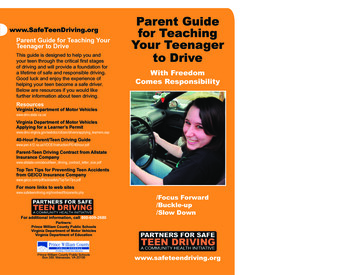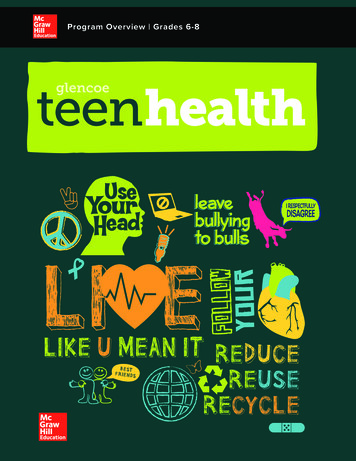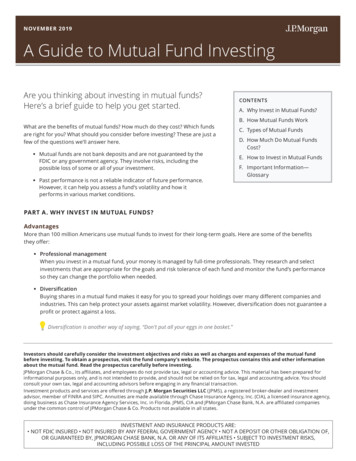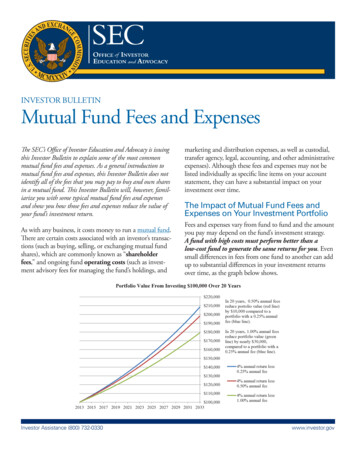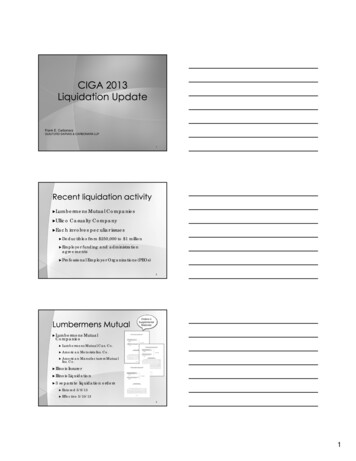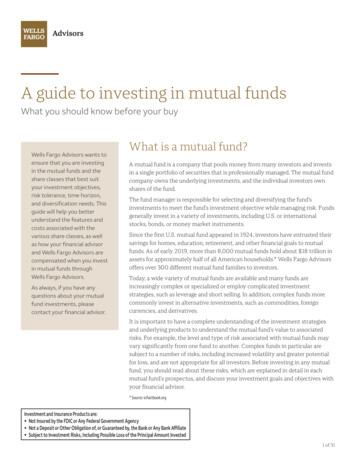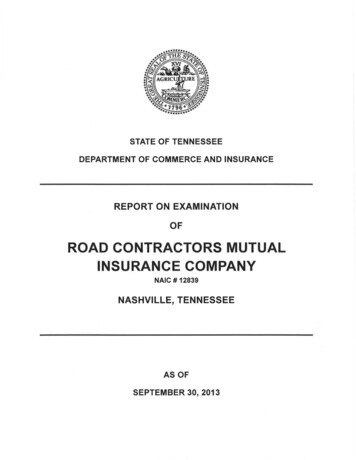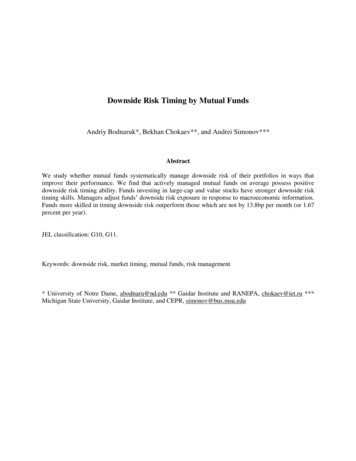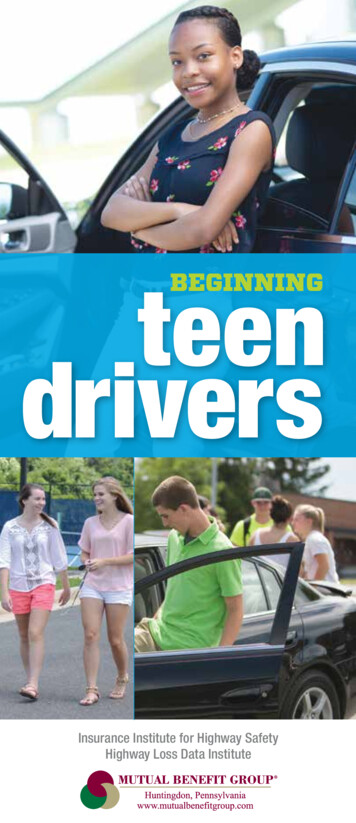
Transcription
teendriversBEGINNINGInsurance Institute for Highway SafetyHighway Loss Data Institute
BEGINNING DRIVERSAND CRASH RISKGetting a license is an important milestone forteens and parents, but being a beginning drivercarries special risks. Per mile traveled, teenagedrivers are more likely to be involved in a crashthan all but the oldest adult drivers. During theirfirst months of licensure, teens have a particularly high risk of crashing. One reason is inexperience. Another is immaturity.When teenage drivers crash, the contributing factorsare typically different than adult drivers’ crashes.Characteristics of teens’ fatal crashes include: Driver error. Compared with adults’ fatal crashes,those of teens more often involve driver error. Speeding. Excessive speed is a factor in abouta third of teens’ fatal crashes.200150Inexperienced 16 year-olds haveespecially high crash rates per 10,000drivers in their first months of licensure100501-23-45-6months of licensure7-89-10 Single-vehicle crashes. Many fatal crashes involve only the teen’s vehicle. Typically these arehigh-speed crashes in which the teenage driverloses control. Passengers. Teens’ fatal crashes are more likelyto occur when young passengers are riding withthem. This risk increases with the addition of every passenger. Just over half of teen passengerdeaths occur in crashes with teen drivers.
Alcohol. Teens are less likely than adults todrive after drinking alcohol, but their crash riskis substantially higher when they do. About 1 in5 fatally injured teen drivers have blood alcoholconcentrations of 0.08 percent or more. Night driving. Per mile driven, the fatal crashrate of 16-19 year-olds is about 4 times as highat night as it is during the day. Low safety belt use. Nearly half of teens whoare killed in crashes aren’t using their safety belts.HOW GRADUATEDLICENSING CAN HELPCrashes are the leading cause of death amongAmerican teens, accounting for nearly a third of alldeaths of 16-19 year-olds. Graduated driver licensing (GDL) laws help to reduce this toll by slowly introducing teenagers to more complex driving tasksas they mature and gain skills. Driving privilegesare phased in to restrict beginners’ initial experience behind the wheel to lower risk situations. Therestrictions gradually are lifted, so teenagers aremore experienced and mature when they get theirfull, unrestricted licenses.
Graduated licensing laws have reduced teenagers’crash rates in the United States, Canada and NewZealand. All U.S. states have such laws, but theyaren’t all strong.The toughest graduated licensing provisions inthe U.S. are a minimum permit age of 16, at least70 hours of supervised practice driving during thelearner’s stage, a minimum intermediate license ageof 17, and during the intermediate stage, a night driving restriction starting at 8 p.m. and a ban on drivingwith other teens in the vehicle. No state currentlyhas all of them. An online calculator developedby the Insurance Institute for Highway Safetyshows the effects forevery state and theDistrict of Columbiaof strengtheningor weakening thefive key provisions:permit age, practice driving hours,license age, andnight driving andpassenger restricTeens have a particularly hightions. To see estirisk of crashing during theirmates for your state,first months of licensure. GDLgo to iihs.org/gdl.helps reduce crash rates.WHAT PARENTSCAN DO TO HELPWith or without a strong graduated licensing law,parents can establish effective rules. In particular: Don’t rely solely on driver education. Highschool driver education may be a convenientway to introduce teens to the mechanics ofdriving, but it doesn’t produce safer drivers.Poor skills aren’t always to blame for teencrashes. Teenagers’ attitudes, experience anddecision-making matter more. Young people
tend to overestimate their skills and underestimate their vulnerabilities. Training and educationdon’t change these tendencies. Peers are influential, but parents have much more influencethan typically is credited to them.For an overview of teen driver laws in your stateand to see how they could be improved, go toiihs.org/gdl Know the law. Become familiar with yourstate’s restrictions on young drivers, and feelfree to set tougher rules. To review state laws,go to iihs.org/laws. Restrict night driving. About 2 of 5 youngdrivers’ fatal crashes occur between 9 p.m.and 6 a.m. The problem isn’t just that driving inthe dark requires more skill behind the wheel.Late outings tend to be recreational, and eventeens who usually follow the rules can be easilydistracted or encouraged to take risks. Consider setting an early curfew for your teen, evenif your state has a later one.
Restrict passengers. Teenage passengersriding in a vehicle with a beginning driver candistract the driver and encourage greater risktaking. While driving at night with passengersis particularly lethal, many of the fatal crashesinvolving teen passengers occur during the day.The best policy is to restrict teenage passengers, especially multiple teens, all the time.40016-17-year-old drivers have higher death riskper mile traveled when passengers ride alongPercent change in death risk with passengersyounger than 21 vs. no passengers30020010001 passenger2 passengers3 passengersSource: AAA Foundation for Traffic Safety Supervise practice driving. Take an active rolein helping your teen learn to drive. Plan a seriesof practice sessions in a variety of situations,including night driving. Give beginners time towork up to challenges like driving in heavy traffic, on freeways, or in snow and rain. Require safety belt use. Don’t assume thatyour teen will buckle up when driving alone orout with peers. Insist on belts. Prohibit driving after drinking alcohol. Make itclear that it’s illegal and dangerous to drive afterdrinking alcohol or using any other drug. Consider a monitoring device. Various typesof in-vehicle devices are available to parentswho want to monitor their teens’ driving. Thesesystems flag risky behavior such as speeding,sudden braking, abrupt acceleration and nonuse of belts. Research shows a monitoring de-
Looking for a vehicle for your teen driver? A current IIHSTOP SAFETY PICK or TOP SAFETY PICK award winner isideal (iihs.org/ratings). If a new model isn’t in your budget, consult the IIHS list of recommended used vehiclesfor teens (iihs.org/teenvehicles).vice can reduce teens’ risks behind the wheel.Some insurers offer discounts for using one. Choose vehicles with safety in mind. Teensshould drive vehicles that reduce their chancesof crashing in the first place and then protectthem from injury in case they do crash. Bigger, heavier vehicles are safer. Small and minicars don’t offer the best protection in a collision compared with larger vehicles, and IIHSdoesn’t recommend them for teens. Avoidhigh-horsepower models that might encourageteens to speed. Look for vehicles that have thebest safety ratings. Two musts are side airbagsto protect people’s heads in crashes (standardon most 2008 and later models) and electronicstability control to avoid crashes (standard on2012 and later models). Be a role model. New drivers learn a lot by example, so practice safe driving yourself. Teenagers who have crashes and violations often haveparents with similar driving records.
Insurance Institute for Highway SafetyHighway Loss Data Instituteiihs.orgyoutube.com/IIHSiihs.org/rss@IIHS autosafetyMEMBER GROUPSAAA CarolinasAcceptance InsuranceAIG PC Global Services, Inc.Alfa Alliance Insurance CorporationAlfa InsuranceAllstate Insurance GroupAmerican Family Mutual Insurance CompanyAmerican NationalAmeriprise Auto & HomeAmica Mutual Insurance CompanyAuto Club EnterprisesAuto Club GroupAuto-Owners InsuranceBankers Insurance GroupBitco Insurance CompaniesCalifornia Casualty GroupCenstat Casualty CompanyCHUBBColorado Farm Bureau Mutual Insurance CompanyConcord Group Insurance CompaniesCOUNTRY FinancialCSAA Insurance GroupCSE Insurance GroupDirect General CorporationElephant Insurance CompanyErie Insurance GroupEsuranceFarm Bureau Financial ServicesFarm Bureau Insurance of MichiganFarm Bureau Mutual Insurance Company of IdahoFarmers Insurance GroupFarmers Mutual Hail Insurance Company of IowaFarmers Mutual of NebraskaFlorida Farm Bureau Insurance CompaniesFrankenmuth InsuranceGainsco InsuranceGEICO CorporationThe General InsuranceGeorgia Farm Bureau Mutual Insurance CompanyGoodville Mutual Casualty CompanyGrange InsuranceHallmark Financial ServicesHanover Insurance GroupThe HartfordHaulers Insurance Company, Inc.Horace Mann Insurance CompaniesICW GroupImperial Fire & Casualty Insurance CompanyIndiana Farmers Mutual Insurance CompanyInfinity Property & CasualtyKemper CorporationKentucky Farm Bureau Mutual Insurance CompaniesLiberty Mutual Insurance CompanyLouisiana Farm Bureau Mutual Insurance CompanyThe Main Street America GroupMercury Insurance GroupMetLife Auto & HomeMississippi Farm Bureau Casualty Insurance CompanyMMG InsuranceMunich Reinsurance America, Inc.Mutual Benefit GroupMutual of Enumclaw Insurance CompanyNationwideNew Jersey Manufacturers Insurance GroupNodak Mutual Insurance CompanyNorfolk & Dedham GroupNorth Carolina Farm Bureau Mutual Insurance CompanyNorthern Neck Insurance CompanyOhio Mutual Insurance GroupOld American County Mutual Fire Insurance CompanyOld American Indemnity CompanyOregon Mutual Insurance CompanyParamount Insurance CompanyPekin InsurancePEMCO InsurancePlymouth Rock AssuranceProgressive InsurancePURE InsuranceQualitas Insurance CompanyThe Responsive Auto Insurance CompanyRider InsuranceRockingham GroupSafe Auto Insurance CompanySafeco InsuranceSamsung Fire & Marine Insurance CompanySECURA InsuranceSentry InsuranceShelter Insurance CompaniesSompo AmericaSouth Carolina Farm Bureau Mutual Insurance CompanySouthern Farm Bureau Casualty Insurance CompanyState Auto Insurance CompaniesState Farm Insurance CompaniesTennessee Farmers Mutual Insurance CompanyTexas Farm Bureau Insurance CompaniesThe Travelers CompaniesUnited EducatorsUSAAUtica National Insurance GroupVirginia Farm Bureau Mutual InsuranceWest Bend Mutual Insurance CompanyWestern National Insurance GroupWestfield InsuranceXL Group plcFUNDING ASSOCIATIONSAmerican Insurance AssociationNational Association of Mutual Insurance CompaniesProperty Casualty Insurers Association of AmericaJuly 2016
riding in a vehicle with a beginning driver can distract the driver and encourage greater risk-taking. While driving at night with passengers is particularly lethal, many of the fatal crashes involving teen passengers occur during the day. The best policy is to restrict teenage passen-gers, e



